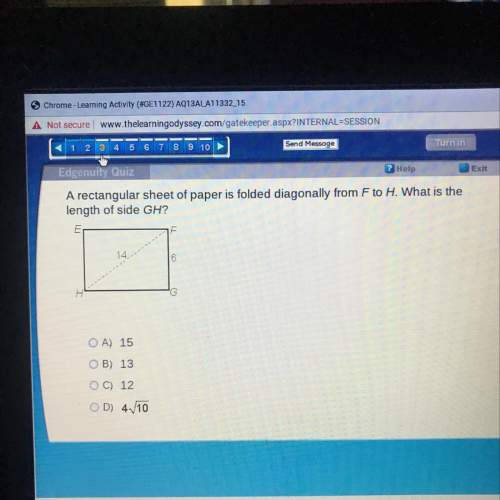
Mathematics, 05.07.2019 22:50 admiralaj85
The sum of the differences must be zero for any distribution consisting of n observations. a. true b. false

Answers: 1
Another question on Mathematics

Mathematics, 21.06.2019 18:00
Acompany wants to reduce the dimensions of its logo by one fourth to use on business cards. if the area of the original logo is 4 square inches, what is the area of the logo that will be used on the business cards?
Answers: 1

Mathematics, 21.06.2019 22:00
Write a description of each inequality. 1. -5a + 3 > 1 2. 27 - 2b < -6 (this < has a _ under it) 3. 1/2 (c + 1) > 5 (this > has a _ under it)
Answers: 3

Mathematics, 22.06.2019 02:00
If p(x) is the total value of the production when there are x workers in a plant, then the average productivity of the workforce at the plant is a(x) = p(x) x . (a) find a'(x). a'(x) = xp'(x) − p(x) x a'(x) = xp'(x) − p(x) x2 a'(x) = p'(x) − p(x) x a'(x) = xp'(x) − p'(x) x2 a'(x) = p'(x) − xp(x) x2 why does the company want to hire more workers if a'(x) > 0? a'(x) > 0 ⇒ a(x) is ; that is, the average productivity as the size of the workforce increases. (b) if p'(x) is greater than the average productivity, which of the following must be true? p'(x) − xp(x) > 0 p'(x) − xp(x) < 0 xp'(x) − p'(x) > 0 xp'(x) − p(x) < 0 xp'(x) − p(x) > 0
Answers: 2

Mathematics, 22.06.2019 03:00
In this problem, we explore the effect on the standard deviation of multiplying each data value in a data set by the same constant. consider the data set 14, 6, 8, 15, 15. (a) use the defining formula, the computation formula, or a calculator to compute s. (round your answer to one decimal place.) s = 4.28 (b) multiply each data value by 3 to obtain the new data set 42, 18, 24, 45, 45. compute s. (round your answer to one decimal place.) s = 12.83 (c) compare the results of parts (a) and (b). in general, how does the standard deviation change if each data value is multiplied by a constant c? multiplying each data value by the same constant c results in the standard deviation remaining the same. multiplying each data value by the same constant c results in the standard deviation being |c| times as large. multiplying each data value by the same constant c results in the standard deviation increasing by c units. multiplying each data value by the same constant c results in the standard deviation being |c| times smaller. (d) you recorded the weekly distances you bicycled in miles and computed the standard deviation to be s = 3.8 miles. your friend wants to know the standard deviation in kilometers. do you need to redo all the calculations? yes no given 1 mile ≠1.6 kilometers, what is the standard deviation in kilometers? (enter your answer to two decimal places.)
Answers: 1
You know the right answer?
The sum of the differences must be zero for any distribution consisting of n observations. a. true...
Questions



English, 21.10.2021 14:00

Mathematics, 21.10.2021 14:00

History, 21.10.2021 14:00

Mathematics, 21.10.2021 14:00



Mathematics, 21.10.2021 14:00

Chemistry, 21.10.2021 14:00

Geography, 21.10.2021 14:00

Mathematics, 21.10.2021 14:00

Mathematics, 21.10.2021 14:00


Mathematics, 21.10.2021 14:00

English, 21.10.2021 14:00







